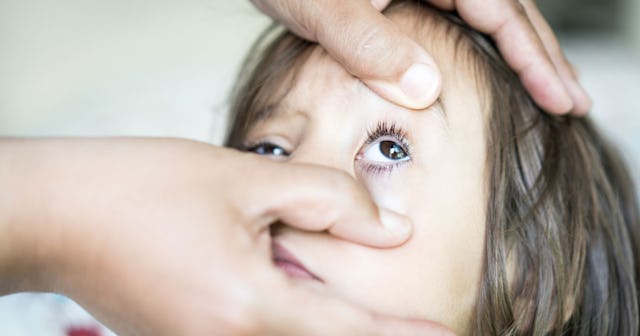What You Need To Know To Treat Pinkeye At Home — And When To See A Doctor

When my kids were two, they brought the dreaded strep throat home from daycare. And as if that wasn’t horrible enough, a couple of days later, both of them woke up with their eyes crusted shut. Their new ailment was clear before I took them to the doctor for an official diagnosis: pinkeye.
They had all of its classic symptoms: red and swollen eyes, increased eye secretions, and they complained of them feeling itchy, burning, and painful. Growing up with two ophthalmologists in my family, I knew better than to wait it out under their circumstances.
Eye infections can quickly turn serious in young children, and a physician should evaluate kids with an eye infection as soon as possible, the American Academy of Ophthalmologists’ website states.
Pinkeye is also commonly caused by allergies, irritants, and viral infections, coinciding with a cold, upper respiratory infection, or COVID. (If you or your child are showing symptoms of COVID along with signs of pinkeye, it’s best to seek a physician’s advice about the next steps, as transfer of the virus is possible through eye secretions.)
Suppose, though, the cause of your or your child’s pinkeye is bacterial, much like in my children’s situation. A physician will determine the infection is bacterial and may prescribe antibacterial drops, which may shorten the duration of the infection and offer some relief.
But even when the infection is bacterial, pinkeye generally resolves itself in one to two weeks, begging the question: are antibacterial drops overprescribed by physicians?
In a 2016 study by Ophthalmology, experts found that 6 out of 10 people had antibiotic eye drops prescribed for them when they may have been unnecessary.
“The proportion of patients who filled prescriptions for antibiotics was indeed much higher than we had expected,” co-author of the study Dr. Joshua Stein, director of the Center for Eye Protection and Innovation at the University of Michigan, told TIME.
Some physicians may prescribe antibiotic drops to err on the side of caution, Stein says. Regardless, Stein recommends patients ask their physicians how confident they are that their infection is bacterial.
Some at-home treatments include:
- Applying warm and cool compresses to the affected eye (clean and cool or warm wet washrags do wonders).
- Using over-the-counter pain medication as needed.
- Asking your doctor about over-the-counter lubricating eye drops.
- Taking over-the-counter allergy medicine if allergies cause conjunctivitis.
You can take steps to prevent spreading infection by washing your hands after coming in contact with infected eyes, washing pillowcases and sheets every day, and cleaning glasses regularly. Those with pinkeye should also remain at home when symptomatic or feverish.
Make sure you teach your kids how pink eye can spread. Ensure they’re using new contacts, not sharing makeup, avoiding touching their eyes, and washing their hands regularly throughout the day.
Those who are infected should not:
- Wear contacts.
- Share anything that touches the eyes.
- Use redness-reducing eye drops.
- Reuse old makeup.
- Put anything in the eye that a physician does not okay.
When in doubt, it’s always best to notify your ophthalmologist or primary care physician and let them decide the best course of action for your pinkeye treatment. But with any luck, you should be back to your bright-eyed self in two weeks or less.
This article was originally published on